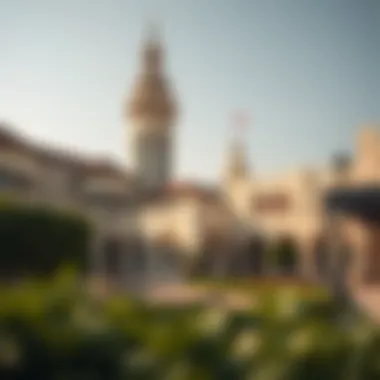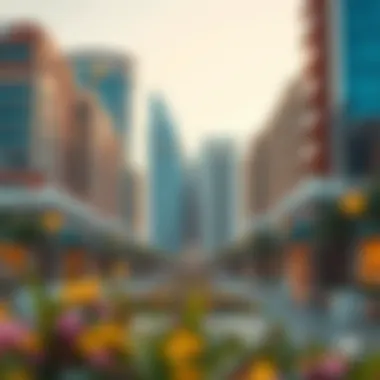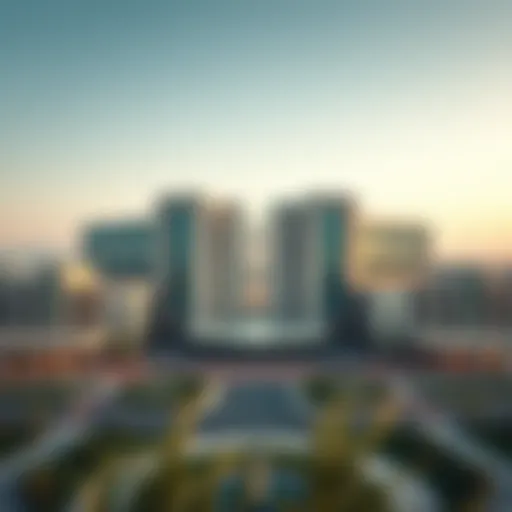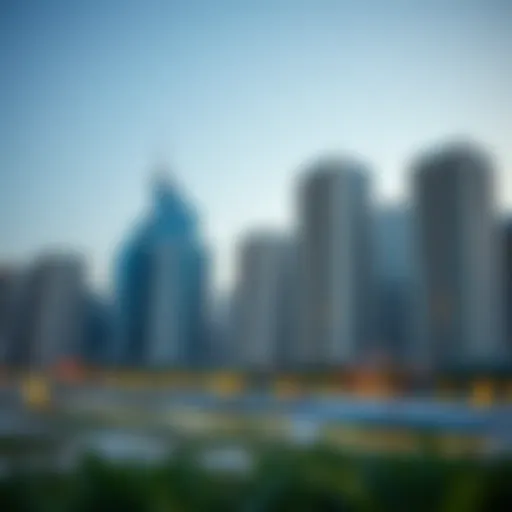The Distance from Jumeirah to Dubai: Connectivity Insights


Intro
The journey from Jumeirah to the heart of Dubai unfolds a tapestry rich with connectivity and significance. This most prestigious neighborhood is not just a stretch of luxurious villas and vibrant shorelines; it encapsulates the essence of modernity blending seamlessly with tradition. Understanding this distance, both geographical and social, opens a treasure trove of insights for residents and visitors alike.
As we navigate through the intricacies of Jumeirah’s proximity to the broader expanse of Dubai, it’s essential to consider the transportation options that make this relationship particularly dynamic. From private cars to public transport, every mode carries its unique implications on the lifestyle choices of those who thrive in this coveted locale.
Moreover, one cannot overlook the cultural landscape that transforms the notion of distance into a more profound contemplation of accessibility. Whether it’s a quick dash to the bustling souks or a serene escape to the tranquil beaches, the geographical alignment of Jumeirah plays a crucial role in shaping daily experiences.
Keeping these multifaceted connections in mind, we delve deeper into understanding not only how far apart Jumeirah is from the surrounding key locations in Dubai but also what this distance means for the residents. Are the attributes of community engagement and luxury real estate influenced by this proximity? Let’s embark on this exploration to uncover the layers of significance woven throughout this well-connected neighborhood.
Prolusion to Jumeirah
Jumeirah stands as a prominent neighborhood in Dubai, symbolizing luxury and sophistication. Its significance in the urban tapestry of Dubai is not just defined by its beautiful beaches and upscale properties, but it encapsulates a myriad of socio-economic and cultural factors that contribute to its allure. Understanding Jumeirah provides visitors and residents alike a deeper insight into the making of modern Dubai and the lifestyle that comes with it.
Jumeirah as a Notable Neighborhood
Regarded as one of the most desirable areas in Dubai, Jumeirah boasts a unique blend of residential, commercial and leisure offerings. It is home to some of the most luxurious hotels in the world, including the iconic Burj Al Arab, and has become synonymous with a beachside lifestyle that attracts both the wealthy and expatriates looking for a comfortable home. The beachfront properties along Jumeirah Beach Road are not just prized real estate; they also signify a lifestyle rich in leisure activities, from sunbathing to water sports.
Residents enjoy a plethora of amenities including high-end shopping, diverse dining options, and cultural centers that shape the character of this community. Its close-knit familial atmosphere allows expatriates to connect while also fostering a unique environment for local Emiratis to thrive. The blend of traditional and contemporary architectures further emphasizes Jumeirah's position as a cultural melting pot.
Historical Context of Jumeirah
To truly appreciate Jumeirah, one must delve into its historical significance. Originally, Jumeirah was a series of small fishing villages, predominantly inhabited by the local Bedouin tribes. However, the discovery of oil in the 20th century marked a turning point for the region, leading to rapid urban development. The once quaint coastal community transformed dramatically into a vibrant neighborhood characterized by its opulent lifestyle.
In the 1970s, Dubai's leaders strategically positioned Jumeirah as a focal point for tourism, culminating in the establishment of luxury resorts and attractions. This decision not only elevated the neighborhood’s status on the global stage but also introduced an influx of expatriates seeking new opportunities, enriching the area’s cultural diversity.
"The evolution of Jumeirah starkly reflects Dubai's broader growth narrative, illustrating how a small fishing enclave morphed into a global hub of tourism and lifestyle."
In summary, Jumeirah’s blend of historical roots and modern sophistication plays a key role in the overarching narrative of Dubai, making it a fascinating subject for those interested in the city's developmental journey. From residents to investors, understanding Jumeirah’s essence is crucial for anyone looking to engage with what Dubai has to offer.
Understanding the Distance
In the bustling city of Dubai, the distance between neighborhoods can often dictate much more than just geography. The proximity of Jumeirah to Dubai city center has implications that extend into various aspects of life, whether it involves real estate, culture, or day-to-day connectivity. Understanding this distance is fundamental for investors, homebuyers, and expats alike, as it informs not only lifestyle choices but also economic opportunities.
Jumeirah is known for its luxurious beachside living and upscale amenities, but its significance stretches beyond its boundaries. Many residents and visitors find that the ease of transport to Dubai's core business districts is a major draw. An astute understanding of this distance also allows potential homeowners to assess whether the investment aligns with their lifestyle preferences and professional engagements.
Measuring Jumeirah's Distance from Dubai City Center
When one considers the physical distance between Jumeirah and the heart of Dubai, it's crucial to note that measurements can vary based on the specific locations being referenced. Essentially, the distance from Jumeirah to the Dubai Mall, one of the city's premier destinations, stretches about 15 kilometers. However, with varying routes and transportation options available, this journey might take anywhere from 20 minutes up to an hour, especially during peak traffic hours.
Several routes connect Jumeirah with key areas of Dubai, and using modern navigation tools can provide precise estimations for various times of the day. Locals often prefer taking the Sheikh Zayed Road, one of the major highways in the UAE, which can be a smooth and efficient route depending on congestion levels. Alternatively, taking the scenic route along the coastline offers a more leisurely drive, albeit a bit longer with potential stops along the way.
Factors Influencing Distance Perception
Not all distances are created equal, particularly in how people perceive them. Several factors can affect the perceived distance from Jumeirah to other parts of Dubai, including:
- Traffic Conditions: Dubai is notorious for its traffic jams, particularly during rush hours. For instance, what might be a straightforward 15-kilometer drive can become a frustrating expedition.
- Availability of Public Transport: Dubai’s metro system is a viable option. The nearest metro station is a short bus ride away, and from there, the ride into the city can be quite swift.
- Cultural Landmarks: The vibrancy of Dubai isn’t just a matter of distance on a map; it’s also about the cultural touchstones along the way. Visitors might find themselves wandering into unique shops or attractions, thereby extending their ‘distance’ experience in a way that makes time fly.
- Lifestyle Preferences: For many, the journey isn’t just about reaching a destination but also about the experiences encountered along the way. This might include fine dining, beachside views, or art galleries.
In short, while the physical distance between Jumeirah and Dubai city center can be measured, the subjective experiences of traveling that span well beyond mere kilometers contribute to the overall significance of the location. Understanding these connections provides valuable insights for anyone looking to navigate life in Dubai.
Transportation Options
Understanding the transportation options between Jumeirah and the broader Dubai area is essential for anyone considering a visit or a move to this vibrant part of the city. Connectivity plays a significant role not only in convenience but also in shaping the lifestyle of its residents and visitors. Efficient transportation systems enhance accessibility, bolster real estate value, and contribute to the overall appeal of the neighborhood. Let’s break down the key elements involved.
Public Transport Connections


Metro Services
The Dubai Metro is often hailed as a game changer in terms of urban mobility, providing a fast and efficient means of travel. Specifically, the metro's Red Line includes stops that cater to the Jumeirah area, linking it directly to important hubs such as the Dubai Financial Centre and the Burj Khalifa. This connectivity is a critical asset for anyone working or exploring the commercial heart of the city. The metro is not only cost-effective but also avoids the common frustrations of traffic congestion.
One unique feature of the metro system is its air-conditioned carriages, which offer respite from the sweltering Dubai heat. That’s a big deal during the peak summer months. However, although generally smooth, the metro can experience busy periods, particularly during rush hours, which might be a drawback for some commuters. Still, many consider it a worthwhile option given its pace and reliability.
Bus Routes
Dubai’s bus network complements the metro and provides extensive service throughout the city, including Jumeirah. Buses run frequently, making them a convenient option for those who need to travel to lesser-known spots not directly serviced by the metro. A standout feature of the bus system is its integration with the Nol card, making fare payment seamless across various modes of transportation.
While buses can sometimes be less predictable than the metro in terms of timing, they offer a cost-effective alternative that ensures coverage of nearly all urban areas. Notably, buses are often equipped with designated stop announcements and digital displays, making it easier for travelers unfamiliar with the routes. Despite this, waiting times can vary, particularly during non-peak hours.
Driving Distances and Routes
Key Roadways
For those who prefer to drive, several major roadways connect Jumeirah with the rest of Dubai, making it a straightforward route for motorists. The Sheikh Zayed Road is the primary corridor, linking suburban areas to the heart of the city. This roadway is pivotal as it facilitates quick access to various central locations and has beautiful ocean views, especially when traveling towards the coast.
A unique aspect of Key Roadways includes multiple lanes that help accommodate heavy traffic loads. However, be mindful of peak traffic times that can extend travel durations. A significant perk of driving is the ability to enjoy the scenic routes that showcase Dubai’s architectural marvels, and the option to park closer to your destination.
Traffic Considerations
Traffic can be a double-edged sword in Dubai, especially during rush hours. Being aware of traffic patterns can drastically improve commute times. Knowing when to avoid peak travel times on roadways like Sheikh Zayed Road saves both time and frustration. There are benefits to using traffic-growing applications, like Google Maps, which provide real-time updates, helping navigate through congested areas.
"Effective transportation enhances accessibility, boosts real estate value, and attracts visitors to Jumeirah's vibrant lifestyle."
Understanding these factors informs not only how residents commute but enriches the experience of those who come to explore the rich cultural and urban offerings in and around Jumeirah.
Cultural Significance
Understanding the cultural significance of Jumeirah provides not just a glimpse into the vibrant lifestyle of the community, but also highlights how this neighborhood plays a crucial role in shaping Dubai's identity. The cultural presence here, manifested through numerous landmarks and events, showcases the rich history and progressive vision that characterizes the city. By delving into the cultural aspects of Jumeirah, we gain insight into why its distance from the rest of Dubai is more than just geographical; it's about the interplay of history, tradition, and modernity.
Jumeirah's Cultural Landscape
Iconic Landmarks
In Jumeirah, iconic landmarks stand tall, telling stories of heritage and contemporary developments. The Burj Al Arab, often recognized as a symbol of luxury and hospitality, isn't just a hotel; it represents Dubai's ambition and architectural prowess. Located on its own island, the striking sail-shaped structure draws visitors from around the world, contributing significantly to the region’s tourism. Its sheer size and design make it an enduring point of interest for both locals and tourists, reinforcing the area's reputation as a hub of opulence. However, the burden of such grandeur can also evoke discussions about authenticity and the preservation of local culture amidst lavish developments.
Consider the Jumeirah Mosque as well, which stands as a beacon of tolerance and understanding. Open to the public for tours, this mosque facilitates intercultural dialogue, showcasing Islamic architecture’s beauty while inviting visitors to learn about local traditions. This particular landmark serves not just as a religious site, but also as a bridge connecting communities. The contrast between these landmarks—one epitomizing luxury and the other inviting understanding—emphasizes Jumeirah's multifaceted cultural landscape.
Cultural Events
Cultural events in Jumeirah are similarly reflective of the area's diverse character. Annual festivals such as the Dubai Shopping Festival and the Jumeirah Beach Festival are more than mere celebrations; they stand as testaments to the community's engagement with both heritage and global influences. These events draw participants from various backgrounds, promoting a sense of belonging and unity. They also provide an avenue for local artisans and performers to showcase their crafts and talents, contributing to a thriving arts scene.
Furthermore, events such as the Dubai Summer Surprises feature cultural activations that align closely with community interests, ensuring inclusivity and wider participation. However, there can be a dilemma as well; while these large-scale festivals promote economic activity, they can sometimes overshadow local, smaller gatherings that might hold more historical significance.
Impact on Dubai's Cultural Identity
The cultural significance of Jumeirah is further magnified by its influence on Dubai's broader cultural identity. The locality serves as a microcosm of the city itself—melding the traditional with the contemporary. As communities within Dubai blend, Jumeirah stands out as an area that embodies this fusion. Such balance reflects in its education institutions, art galleries, and culinary offerings, which invite innovation while respecting historical contexts.
In summary, Jumeirah’s cultural significance is layered, with its landmarks and events contributing richly to the narrative of Dubai. They act as a mirror reflecting the city’s aspirations while offering a space for community engagement and intercultural dialogue. This duality not only enhances the neighborhood’s appeal but also plays a vital role in elevating Dubai's cultural identity on the global stage.
Real Estate Trends in Jumeirah
The dynamic nature of the real estate market in Jumeirah reflects broader trends in Dubai. Located by the coastline, this neighborhood is often seen as a beacon of luxury living. Investors and homebuyers find it attractive not just for its properties but also for its lifestyle offerings, amenities, and prestige. Understanding these trends can help potential buyers make informed decisions.
Property Value Analysis


When considering the property value in Jumeirah, a few factors come into play. Properties here are consistently featured at the high end of Dubai's market spectrum. Recent studies indicate that the average price per square meter for homes in this area stands taller than in many other neighborhoods across the emirate. For instance, villas overlooking the Arabian Gulf usually command premium prices.
Key elements affecting property values include:
- Location: Proximity to beaches, shopping districts, and recreational areas can significantly increase demand.
- Property Type: Luxury villas and apartments have seen robust appreciation compared to residential flats.
- Market Trends: Economic factors and government policies have a substantial influence on property prices, often making them fluctuate.
These factors not only accentuate the value of owning a piece of real estate in Jumeirah but also contribute to its allure as a sound investment.
Investment Potential
Investing in Jumeirah offers opportunities that can be quite tempting for many. The real estate scene here is often characterized by several investment advantages. Investors can gain substantial returns, especially in a region where luxury real estate is highly coveted.
Considerations for potential investors include:
- Strong Rental Demand: With expatriates making up a significant portion of Jumeirah's population, there is a continuous demand for rental properties.
- High ROI: The rental yields in Jumeirah are competitive, often ranging between 5% to 7%, depending on the property type and location.
- Future Developments: With ongoing and upcoming developments in the Dubai area such as entertainment complexes and parks, the appeal of investing in Jumeirah becomes even clearer.
Real estate in Jumeirah is not just about buying a home; it's about becoming part of a community that values luxury and lifestyle.
Overall, the real estate landscape in Jumeirah remains vibrant, offering prospects for high-yield investment and possibilities for personal residence in one of the most prestigious areas of Dubai. Individuals entering this market should keep a keen eye on the evolving trends, ensuring they are well-informed and strategically positioned for success.
Lifestyle Considerations
Exploring the lifestyle in Jumeirah offers critical insights into what makes this neighborhood a magnet for various residents, visitors, and investors. The blend of luxury, community spirit, and convenient access to urban amenities contributes greatly to the overall attractiveness of this picturesque area. From the architectural aesthetics to the cultural vibe, understanding lifestyle elements helps illustrate why Jumeirah is a preferred choice for many.
Living in Jumeirah
Community Features
Jumeirah is known for its diverse community. Families, young professionals, and expatriates all call this neighborhood home. This melting pot of cultures enhances the overall atmosphere, generating a vibrant environment that fosters social connections.
One of the standout characteristics of community life here is the sense of safety and belonging. Parks, community centers, and social clubs often draw residents together, creating a supportive network. A unique feature of community life in Jumeirah is the communal events often organized by local bodies, such as markets, festivals, and sports clubs. Such gatherings are beneficial for creating relationships and enhancing neighborhood spirit.
However, living in a high-profile area like Jumeirah can come with pressures, particularly in social circles. Maintaining a certain lifestyle is often expected, which might not be feasible for everyone. The cost of living can be high, driving some to seek more affordable alternatives elsewhere. Despite this, the benefits of community engagement often outweigh the downsides, making it a popular choice for many.
Local Amenities
In terms of local amenities, Jumeirah stands out for its wide range of options available right at residents' doorstep. From luxurious dining experiences to upscale shopping malls, the neighborhood caters to all tastes and preferences. One key characteristic of local amenities in Jumeirah is the proximity to the coastline, where residents can enjoy beach access and watersports without straying far from home.
A unique feature of local amenities is the emphasis placed on wellness and leisure activities—all restaurants and shops often provide upscale organic food and lifestyle products, drawing health-conscious individuals.
While the high-quality amenities are appealing, they also come with a premium price tag, which can be a hindrance for some residents. Accessibility to these amenities can vary, depending on which area one resides in within Jumeirah. Nevertheless, the comprehensive offerings contribute to the overall quality of life and make living here an attractive proposition.
Comparison with Other Dubai Neighborhoods
When compared to other neighborhoods in Dubai, Jumeirah often emerges as a leader in terms of both lifestyle and connectivity. Areas such as Dubai Marina and Downtown Dubai provide their own unique benefits, but Jumeirah's serene environment and access to nature give it a distinct edge.
- Dubai Marina: Known for its skyscrapers and nightlife, it attracts a younger crowd but can often feel congested.
- Downtown Dubai: Similar to Marina, it leans heavily towards a business and tourist demographic, which may not be ideal for families.
- Jumeirah: Offers a more relaxed pace with family-friendly parks, spacious villas, and a community centered approach, catering ideally to those who prioritize comfort and lifestyle over just proximity to business hubs.
Overall, Jumeirah sets itself apart not just through lifestyle elements but also through a communal ethos that integrates seamlessly with the luxuries of suburban living.
Visiting Jumeirah: A Practical Guide
The act of visiting Jumeirah is more than just a trip; it’s an experience layered with the unique ambiance of one of Dubai's most prestigious neighborhoods. Exploring this area presents invaluable insights not only into the lifestyle and culture of its residents but also the architectural marvels and entertainment options available. For investors, homebuyers, and tourists alike, understanding how to navigate this luxurious enclave can significantly enhance their experience and appreciation of Dubai.
Jumeirah stands as a testament to sophistication, where modern skyscrapers harmonize with traditional Arabian architecture. Consulting this guide offers a nuanced perspective of what makes Jumeirah an attractive destination.


Attractions and Activities
When it comes to attractions, Jumeirah is brimming with options that cater to a wide array of interests. The first stop for many is the iconic Burj Al Arab, often billed as the world’s only seven-star hotel. Its sail-like silhouette is not just visually striking; it represents the height of luxury hospitality. Visitors can enjoy afternoon tea within its opulent space or simply capture a snapshot against its stunning façade.
Furthermore, the pristine beaches of Jumeirah invite relaxation and recreation. Whether it's sunbathing at the public Jumeirah Beach or engaging in water sports at one of the private beach clubs, the coastal landscape here is captivating. The atmosphere is often lively, with families and friends enjoying the sun and surf.
For culture enthusiasts, the Jumeirah Mosque is another must-visit. As one of the few mosques open to non-Muslims, it provides an invaluable insight into Islamic architecture and offers guided tours aimed at educating visitors about local customs and beliefs.
In addition, there are several parks and green spaces, including the popular Jumeirah Corniche, perfect for leisurely strolls or picnics among the palm trees. Local art galleries and museums pepper the area as well, giving visitors a deeper understanding of the artistic pulse that drives the district.
Dining and Shopping Experiences
Hunger often strikes after an adventure through the attractions of Jumeirah, and this neighborhood does not disappoint in terms of culinary offerings. From street-side eateries to Michelin-star venues, the dining scene is diverse and can satisfy even the most discerning palate. Among the highlights is the Al Mahara restaurant, renowned for its exquisite seafood and distinctive underwater dining experience, offering diners the chance to enjoy their meal surrounded by the sights of the ocean.
Shopping enthusiasts will find themselves in paradise, as Jumeirah boasts a variety of retail options. Boutiques at the Souk Madinat Jumeirah offer a traditional ambiance coupled with luxury brands, along with local artisan handcrafted goods. For high-end shopping, the Mall of the Emirates is just a short drive away, featuring major international brands and the unique indoor ski slope—an unexpected thrill in the desert city.
In summary, the allure of Jumeirah lies in its blend of cultural depth, luxury living, and leisure opportunities. By employing this practical guide, visitors can maximally experience what this vibrant neighborhood has to offer, ensuring a look into the heart of Jumeirah's lifestyle.
"Jumeirah is not just a place, it's a celebration of life, lifestyle, and culture."
For further insights into attractions and practical visits, consider checking additional resources like Visit Dubai for the most recent updates and events happening in Jumeirah.
Future Developments: What Lies Ahead
The landscape of Jumeirah continues to evolve, shaped by innovative projects and long-term urban planning. The focus on future developments is critical for various stakeholders including investors, homebuyers, and even expats seeking a vibrant lifestyle. As a coveted neighborhood, any change here can have rippling effects not just on the immediate area but throughout Dubai. One cannot underestimate the significance of staying in tune with what’s coming next.
Upcoming Projects in Jumeirah
In Jumeirah, several upcoming ventures point to a bright future filled with possibilities. Investors should take note of the new beachfront developments, which aim to draw tourists and residents alike. Projects like the Jumeirah Corniche are designed to enhance connectivity along the coastline, seamlessly blending leisure with local culture. This initiative is expected to attract high-end retail, dining, and recreational facilities, creating a lively atmosphere.
Additionally, the integration of smart urban technologies is becoming a focal point. The introduction of smart parking systems and energy-efficient buildings reflects a trend towards sustainability. As these projects break ground, they promise not just modern conveniences but also an appeal to those who prioritize eco-friendly living.
"The future of Jumeirah isn't just about buildings; it's about creating a community that respects its past while looking towards tomorrow."
Long-Term Urban Planning
Long-term urban planning is an essential framework shaping the resilience and adaptability of Jumeirah. A critical aspect to consider is how these plans accommodate both the local population and the influx of visitors. The authorities are focusing on enhancing public transport links while ensuring that green spaces remain a priority. By developing a balanced urban ecosystem, Jumeirah can maintain its charm while adapting to the growing demands of urban life.
Smart zoning laws are also in place to manage property developments, ensuring that future growth does not come at the cost of livability. This strategic approach prevents overcrowding and maintains Jumeirah's reputation as one of the premier locales in Dubai.
In sum, Jumeirah stands on the brink of transformative growth, marked by both exciting projects and prudent planning. Keeping an eye on these trends will serve investors and residents well, ensuring they remain a step ahead in this thriving neighborhood.
The End
Understanding the relationship between Jumeirah and Dubai is key for various stakeholders, including investors, residents, and visitors. This article has highlighted important elements that outline the importance of knowing the distance between the two areas, focusing on connectivity, accessibility, and cultural context.
Recap of Key Insights
Jumeirah stands out as not only a picturesque locale but also as a hub of luxurious living and cultural significance within Dubai. We've explored a few pivotal points:
- Travel Accessibility: The transportation options connecting Jumeirah with the rest of Dubai make it a highly sought-after place.
- Cultural Significance: Jumeirah isn't just a neighborhood; it's a cultural tapestry that plays a role in shaping Dubai’s overall identity.
- Real Estate Appeal: The ongoing trend of rising property values showcases Jumeirah's potential for long-term investment.
Each of these insights contributes to a broader understanding of Jumeirah’s standing in Dubai, emphasizing why many consider it one of the city’s most significant neighborhoods.
"Jumeirah is a microcosm of what makes Dubai unique: a blend of tradition, luxury, and community."
Final Thoughts on Jumeirah's Role in Dubai
Jumeirah is not just a spot on the map; it represents a slice of life that attracts a diverse range of people—from affluent families to expatriates searching for a piece of paradise. Its beaches, cultural landmarks, and vibrant community make it more than just an attractive neighborhood.
Furthermore, the increasing investment interest signals that Jumeirah's relevance in Dubai's urban landscape is likely to grow. The parallel growth of public transport and infrastructure leads to a promising outlook for both current residents and future investors.
As the city continues to evolve, Jumeirah’s enduring charm and significance illustrate not just where Dubai has been, but also where it is heading. Understanding these dynamics is crucial for anyone considering a stake in this illustrious community, making informed decisions about investments, lifestyle choices, or even just a memorable visit.















